ISSN: 1204-5357
ISSN: 1204-5357
| JEAN-PIERRE LéVY MANGIN, Ph.D Professor Titulaire, Université du Québec en Outaouais, Québec, Canada. Postal Address: 101 rue Saint Jean Bosco, Gatineau (Québec), Canada, J8X 3X7. Email: jean-pierre.levy-mangin@uqo.ca |
| Dr. Jean-Pierre Lévy Mangin is professor titulaire at l′Université du Québec en Outaouais and he teaches in North American and European Universities. He holds two Ph.D’s and is specialized in marketing channels, marketing research, product segmentation, multivariate analysis and structural equation modeling. |
| NORMAND BOURGAULT, DBA Professor, Université du Québec en Outaouais, Québec, Canada. Postal Address: 101 rue Saint Jean Bosco, Gatineau (Québec), Canada, J8X 3X7. Email: normand.bourgault@uqo.ca |
| Dr. Normand Bourgault is professor at l′Université du Québec en Outaouais. He is a specialist on marketing modeling and is a special adviser for Québec government on speciality products. |
| CRISTINA CALVO PORRAL, Ph.D Professor, Universidad de La Coruña, Facultad de CCEE. La Coruña, Spain. Postal Address: Facultad Ciencias Económicas y Empresariales. Departamento de Análisis Económico y Administración de Empresas. Area Comercialización e Investigación de Mercados. Campus de Elviña, 15071, La Coruña. Email: ccalvo@udc.es |
| Dr. Cristina Calvo is professor at the University of La Coruña, Spain. She is a marketing channel and retailing specialist and she worked many years for the fashion industry in Spain. She is visiting professor at l′Université du Québec en Outaouais. |
| OLIVIER MESLY, DBA Professor, Université du Québec en Outaouais, Québec, Canada. Postal Address: 101 rue Saint Jean Bosco, Gatineau (Québec), Canada, J8X 3X7. Email: olivier.mesly@uqo.ca |
| Dr. Mesly is Professor at the Université du Québec en Outaouais. He is specialized in International Trade and in Financial Predation. Professor Mesly has also taught in Central American and Chinese universities. |
| ISSAM TELAHIGUE, Ph.D Professor, Université du Québec en Outaouais, Québec, Canada. Postal Address: 5 rue Saint Joseph, Saint-Jérôme (Québec), Canada, J8Z 0B7. Email: issam.telahigue@uqo.ca |
| Dr. Issam Telahigue is professor at l′Université du Québec en Outaouais. He is a specialist in international marketing, marketing research and modeling. |
| MYCALLE TRUDEL, Ph.D Professor, Université du Québec en Abitibi-Témiscamingue, Québec, Canada. Postal Address: 445, boulevard de l′Université, Rouyn-Noranda (Québec), Canada, J9X 5E4. Email: mycalle.trudel@uqat.ca |
| Dr. Mycalle Trudel is professor at l′Université du Québec en Abitibi-Témiscamingue. She has a Ph.D. in management science and she is a human resource management and law specialist. |
Visit for more related articles at Journal of Internet Banking and Commerce
Based on the Technology Acceptance Model, this paper explores the importance of three moderator variables—‘Risk’ ‘Security’ and ‘Trust’ —in the consumer acceptance of online banking in a Canadian environment. The results highlight the predictive power and suitability of the proposed conceptual model, considering the introduction of three moderator variables. In fact, the findings stress that ‘Risk’ (Perceived Risk) could hamper the use of the internet banking, whereas Security and Trust could enhance the use of online banking.
Keywords |
| Technology Acceptance Model; on-line banking; Perceived Risk; Security on line; Trust; Partial Least Squares; Financial Services. |
INTRODUCTION |
| Many changes have been taking place in the way people make their bank transactions in the very last years. First, they do not need to go to the bank office in order to do banking operations; customers quietly do them from their home computer through the internet electronic system. |
| From the customers’ standpoint, it saves time, money and energy, that could be used to do other productive tasks; and from the bank viewpoint, it dramatically reduces costs, increases revenues and improves the quality of service. |
| Except for cash transactions, on-line financial services allows checking transactions in real time, paying bills, transferring funds, buying and selling stocks or even purchasing different kind of insurance (Polatogliu and Ekin, 2001; Gerrard and Cunningham, 2003; Ainin, Lee and Wee, 2005). Consequently, this could be time saving for businesses and for customers (Legris et al, 2003; Lévy Mangin, J-P et al, 2013). |
| In the present paper, we propose and empirically test the TAM model. This model has been adapted from the TRA model, developed by Fishbein and Ajzen (1975), and tailored for the need of our research. The classical TAM model examines the relationships among the TAM constructs (Mathieson, 1991; Venkatech, 2000), namely, Ease of Use, Perceived Usefulness, Attitude towards Using and Intention to Use. This model has been adapted to the Internet Banking Environment and is actually tested for financial services banking operations offered online in Canada. |
| This research completes the extensive study on the TAM model adding three moderator variables: Confidence, Risk and Security. We propose that these three moderator’ latent variables will have a direct influence on the relationship between Perceived Usefulness and Intention to Use; as well as on the relationship of Attitude towards Using to Intention to Use. |
| In a virtual environment, there are some major factors to take in account when it comes to work with a system that manages financial banking transactions, such as the confidence the customer gives to the system and to the site (or homepage). If customers do not feel confident about a virtual webpage/ homepage and feel some risk about their transactions, they will not be loyal to doing business with that bank (Anderson and Srivanasan, 2003; Gerrard and Cunningham, 2003; Lee, Kwon and Schumann, 2005). Therefore, security becomes important for customers to do business with a virtual bank services’ provider through the internet, as customers’ personal financial information could be available. |
LITERATURE REVIEW |
| The TAM model latent variables analysed will be Ease of Use (and more precisely, Perceived Ease of Use), Perceived Usefulness, Attitude towards Using and Intention to Use. We will add to the analyzed model three-moderator variables, Trust, Security and Risk. |
Ease of Use |
| The variable ‘Ease of Use’ is the first latent variable to in order to accept an information system, because it is the basis of a system use (Davis, Bagozzi and Warshaw, 1989). The ‘Ease of Use’ refers to the degree in which the user thinks that the system used will be easy to use and free of effort in future. A complicated system to use will be perceived as less useful and probably will be abandoned by the user (Davis, 1989). |
| All researches offer evidence of significant effects of ‘Ease of Use’ perception on ‘Intention to Use’ directly or indirectly through ‘Perceived Usefulness’ and ‘Attitude towards Using’ (Venkatesh and Morris, 2000; Moon and Kim, 2001; Wixom and Todd, 2005; Venkatech and Bala, 2008). Thus, ‘Ease of Use’ is a crucial factor for adopting and using services of banking on line (Amin, 2007; Rigopoulos and Askounis, 2007; Gounaris and Koritos, 2008). |
| Perceived Usefulness |
| The behaviour intention is determined by ‘Perceived Usefulness’ however influenced by the technology ‘Ease of Use’, along with the attitude of using this technology. The ‘Perceived Usefulness’ is defined as the subjective probability that the users will increase their productivity using a specific application in its work. That is, the trust and confidence that this application will help users to do a better job, or to do a job more efficiently (Davis, Bagozzi and Warshaw, 1989). |
Attitude towards Using |
| The bank customers’ attitude towards new bank technologies has been extensively analyzed in previous research, since this variable determines which customers are more able (more likely) to use new electronic channels (Al Sukkar and Hassan, 2005; McKechnie, Winklhofer and Ennew, 2006). Consequently, the customers’ attitude has a substantial direct effect on their intentions for using a new technology (Venkatech and Davis, 1996; Dishaw and Strong, 1999; Bobbitt and Dabholkar, 2001). |
Intention to Use |
| The TAM model states that technology use is determined by the intention to have a particular behaviour, which in our study would be the intention to use technology. The intention to use could be predicted by measuring the intention of influencing the user behaviour (Davis, Bagozzi and Warshaw, 1989). More specifically, in the online banking context, some authors suggest that there is a significant relation between ‘Intention to Use’ and the real usage of banking operations through the internet (Walker and Johnson, 2006). |
METHODOLOGY |
The questionnaire |
| Data for this research are issued from a questionnaire handed out to a convenience sample of full time secondary (or high school) students in a Quebecer metropolitan area university, and collected 112 valid responses. The questionnaire is mainly based on previous research on the topic (Lévy Mangin et al, 2011, 2012), and was handed out both in French and in English. The small number of responses obliged us to use the Partial Least Squares method of analysis. |
| The questionnaire is divided in 99 questions, directly linked to bank operations made by internet; questions related to using internet and other general questions related to internet and banking services. Finally, the questionnaire contained 7 questions in order to gather socio-demographic information. Considering the sample description, we could remark that all respondents are at least 18 years old, have a bank account and make ‘some to many’ bank operations using internet (Table 1). |
 |
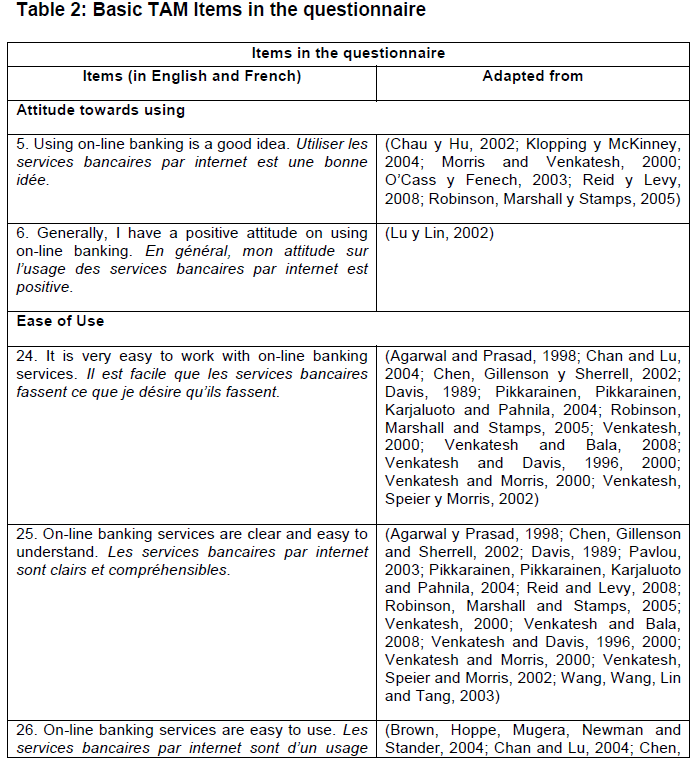 |
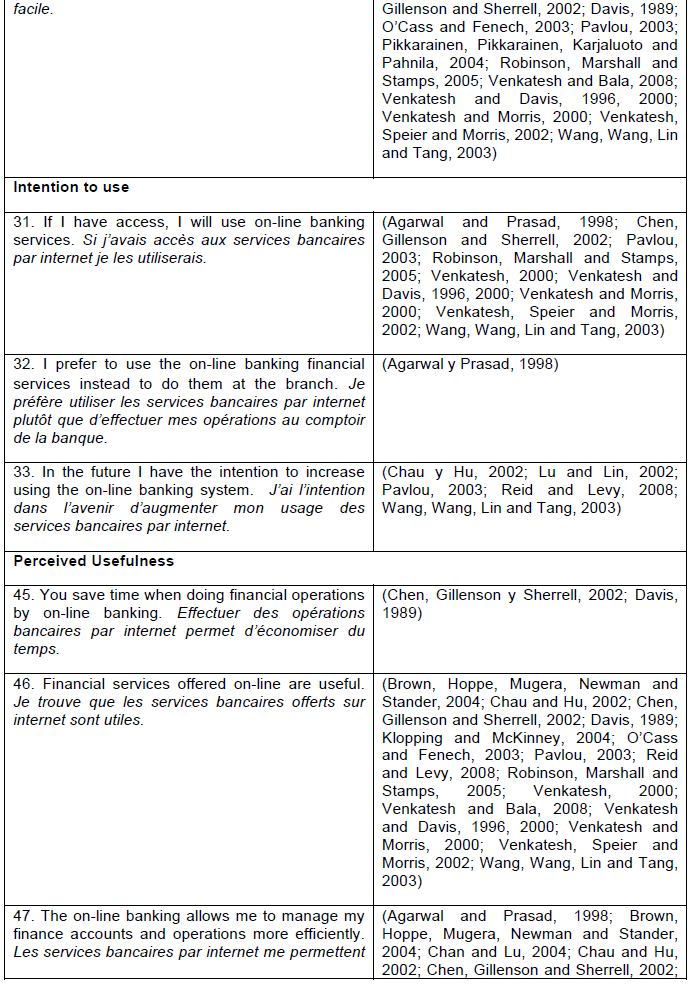 |
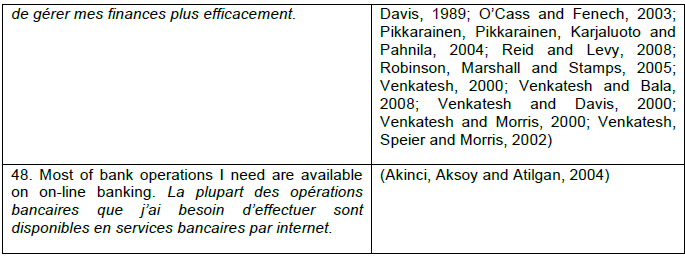 |
BASIC TAM MODEL |
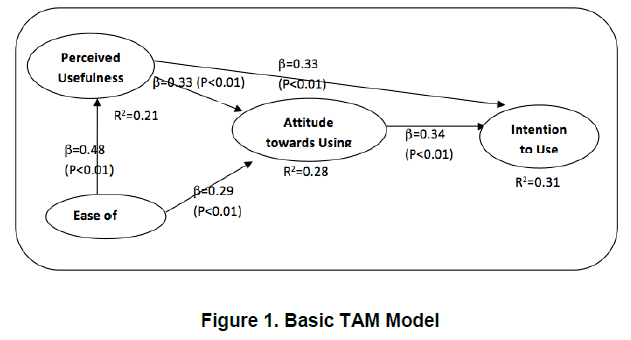 |
| The basic TAM Model is presented with the relationships among variables starting at Ease of Use (EU), which corresponds to the perception of easiness of use of the technology for making financial transactions. Perceived Usefulness (PU) enhances the utility by using this technology in making financial transactions. Thus, we are considering customers’ utility perceptions. The Attitude towards Using (AU) is considered as a mediating variable measuring an attitude on using a particular technology; in this case, making financial transactions using the internet technology. Finally, the behaviour variable is the Intention to Use (IU) this technology when making financial operations in internet. |
| Due to the limited number of responses (112), the TAM models (basic and others) have been analyzed using the Partial Least Squares optimization method. All relations are substantially significant for P<0.01, the explained variance R2 is significant for each dependent latent variable (PU, AU, IU) to get an R2=0.31 for the variable Intention to Use (IU). As we explained before, in the present research three moderating variables have been added all together to the basic model, namely, Trust, Security and Risk. One major goal of this research is to analyse the impact of these three variables on the dependent variable Intention to Use (IU). Therefore, three sub models have been developed by adding the moderating variables one by one. Consequently, we propose that the variables Trust, Security and Risk will moderate the relationships among Perceived Usefulness (PU) and Attitude towards Using (AU) to Intention to Use (IU). |
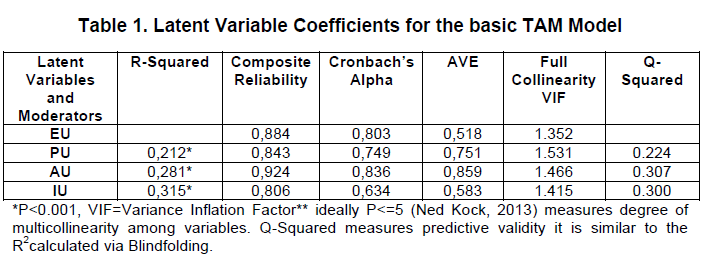 |
| Traditional criteria were used to analyze measurement reliability and validity. Cronbach’s alpha values and Average Variance Extracted measures provided evidence of measurement reliability (Fornell and Larcker 1981; Nunnally and Bernstein, 1994). The basic model shows an adequate suitability, as explained in the literature, given that all path coefficients are significant for P<0.05, R2 and Q-squared are also significant. We also obtained an R2 = 0.315 and a Q-squared = 0.300 for the dependent variable Intention to Use (IU). |
Risk |
| A perceived consumers’ risk on making financial transactions in the internet is conceptualized as the potential negative outcome from an on-line financial transaction, which could include product risk or making transactions on non-demanded financial products. Moreover, the information risk includes the reveal of personal financial statements to other people rather than the bank (Kim, Ferrin, Raghav Rao, 2007). Thus, customers would like to avoid the disclosure of electronic transactions and all personal information to telemarketers, spammers or direct mailers. The illegal collection of data could harm consumers in many ways, such as abusive or fraudulent financial transactions in credit cards, identity thefts and distribution of information to undesirable organizations. Additional conceptualizations associate risk to the consumer’s perception of adverse consequences related to the purchase of a service or a product (Mandel 2003; Bockberger et al, 2007). |
| However, the moderating role of perceived risk has not received all the attention it deserves in the literature, since there is a lack of research on this topic and only very few studies have pointed out the moderating role of Risk in online purchase transactions of products or services (San Martin and Camarero, 2009); and particularly with financial services and bank transactions. Our conceptualization of Risk is related to information risk (security and privacy), stealing data and making non desired operations. Following the advice of Bockberger et al, 2007, we decided to moderate the perceptual perceptions and consumers’ attitudes (both relations PU to IU and AU to IU) with Risk. |
Security and Trust |
| Customers will experience some levels of risk when making business and financial operations through the internet electronic network, like potentially untrustworthy webs, problems using technology not free of bugs, hackers. Hence, some security standards and rules will allow consumers to perform all operations in a safety way. In this way, Security and Trust become crucial to control financial operations with the bank (Friedman et al, 2000). More specifically, Trust becomes particularly important in situations where there is an antecedent of Risk for a product or service purchase transaction. Trust could be defined as behaviour based on personal beliefs about the characteristics of a product or a service, and by extension on the means to acquire them (Grabner-Kräuter and Kaluscha, 2003). This is crucial in a context of financial transactions made on the internet (Gefen, 2003). |
Sub model with Risk as a moderator variable |
| We now will introduce three sub models, corresponding to these with moderation variables Risk, Confidence on line and Security. Finally, we will present the final model comprising the three moderator variables, and all models will be re-specified id-est with the corresponding significant moderating variables. |
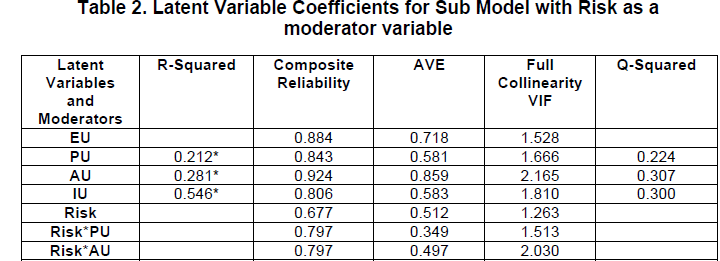 |
| *P<0.001, VIF=Variance Inflation Factor** ideally P<=5 (Ned Kock, 2013) measures degree of multicollinearity among variables. Q-Squared measures predictive validity it is similar to the R2calculated via Blindfolding. |
| In the first sub-model the variable Risk is measured by one single item, Question 41 ‘Using bank and financial services by internet Increases probabilities that non authorised people get my personal and bank data’ which will be used as a moderating variable. We can also notice that the moderating variable Risk has a significant impact on PU and IU (b=0.41, P<0.01), since the b from PU to IU becomes 0.19 from 0.33, a significant descrease is due to the Risk. The same moderating variable has a significant impact on the AU to IU (b=0.39, P=0.19) and the Path coeficient decreases from 0.34 to 0.08, and becomes non significant (P=0.19). |
| If the variable Risk does moderate AU to IU we should not associate the Risk to attitude because the behaviour could not follow. The introduction of Risk as a moderation variable at the AU stage could harm or stop the use of making financial transaction on the internet.The R2 increases substantially from 0.31 to 0.55 with the introduction of Risk as a moderating variable. |
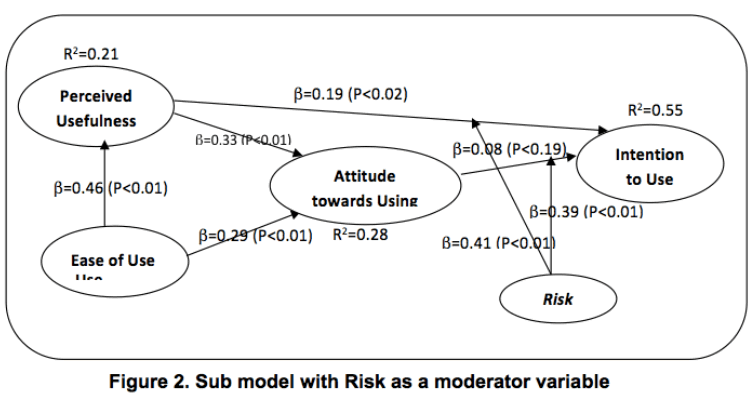 |
Sub model with Security as a moderator variable |
| In the second sub model the variable Security has been measured by six items, Question 40, ‘I am confident that security systems of my bank financial services in internet protect my personal data and financial accounts’, Question 79 ’The web location of my bank or trust union has security measures that protect users’, Question 80 ‘The web location of my bank or trust union protects information against any change or alteration during the connection’, Question 81 ‘’The web location of my bank or trust union has a secure access system and a secure identification system’, Question 83 ‘My bank or trust union appreciates the private character of its users’ financial information’ and Question 84 ‘My bank or trust union will never disclose personal users’ information to a third party’. |
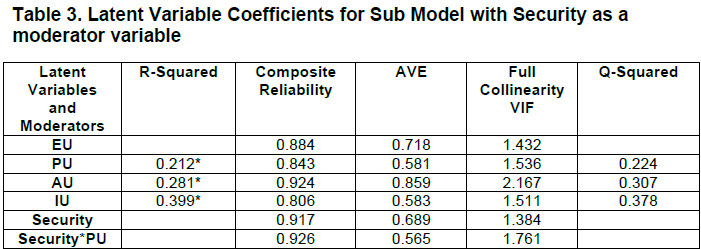 |
| *P<0.001, VIF=Variance Inflation Factor** ideally P<=5 (Ned Kock, 2013) measures degree of multicollinearity among variables. Q-Squared measures predictive validity it is similar to the R2 calculated via Blindfolding. |
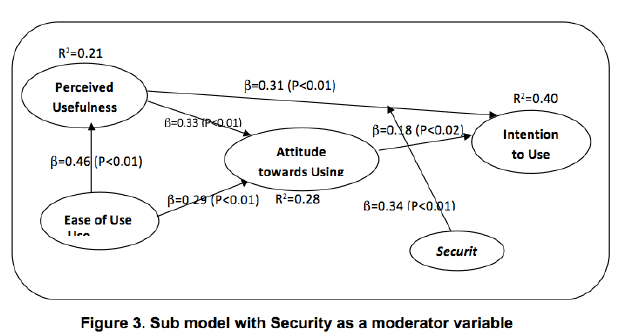 |
| In this model the moderator variable ‘security’, conceptualized as security on line, showed a no significant impact on PU to IU (b= 0.06, P=0.26), in comparison with the base model. For this reason, we re-specify the model and kept the moderation over the relation PU to IU. This could be interpreted that as security being a matter of perception, rather than an attitude, since the impact gives a b= 0.34, P<0.01. The b from the base model decreases from 0.33 to 0.31 from PU to IU, showing a slight decrease, but from 0.34 to 0.18 from AU to IU from the base model due to the indirect effects. The R2 also increased from 0.31 to 0.40. |
Sub model with Trust as a moderator variable |
| In the third model, the moderating variable Trust has been measured by three items, Question 11 ‘My financial institution keeps its promises and engagements’, Question 12 ‘ I am satisfied with products and services offered by my bank’, Question 13 ‘I trust my bank because it takes my interests in account’ |
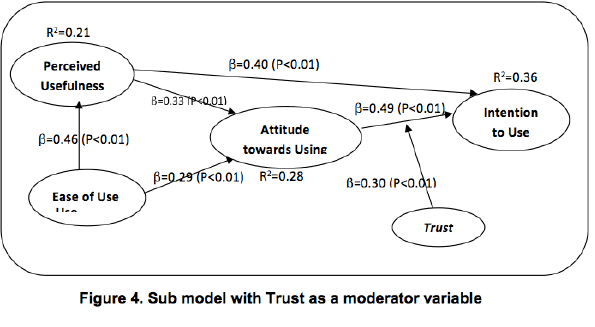 |
| In this sub model, the moderator variable Trust has a positive significant impact on the relation AU to IU, the b =0.30 P<0.01 (the relation is not significant on PU to IU, b=0.01, P=0.45), meaning that Trust to the bank is more than a perception, and could be understood as an attitude that will become an active behaviour. |
| This relation has increased from 0.34 to 0.49 (a difference of 0.15 which is significant) due to the direct effect of Trust on AU to IU and from 0.33 to 0.40 from PU to IU (a difference of 0.07) due to an indirect effect of Trust on PU to IU. |
| Full TAM re-specified model with Risk, Security and Trust as moderator variables. Final Model. |
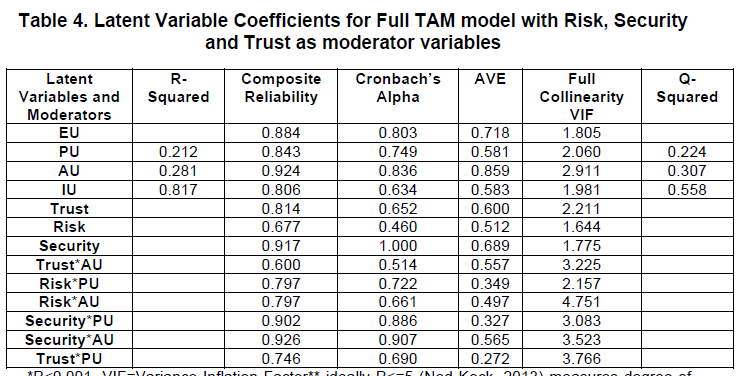 |
| *P<0.001, VIF=Variance Inflation Factor** ideally P<=5 (Ned Kock, 2013) measures degree of multicollinearity among variables. Q-Squared measures predictive validity it is similar to the R2 calculated via Blindfolding. |
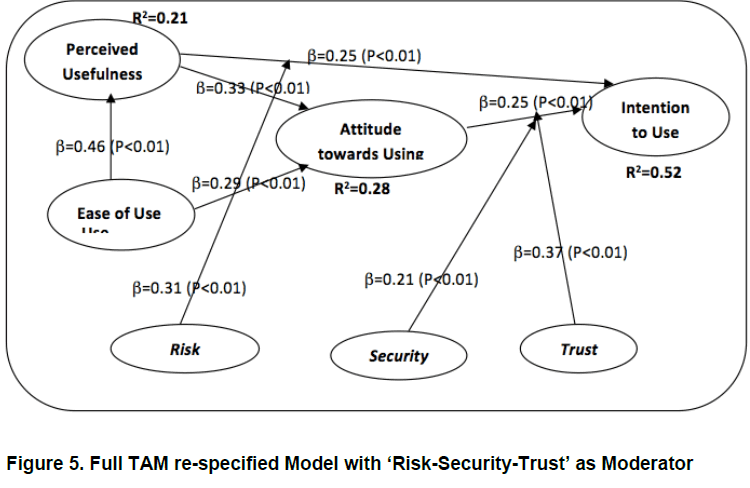 |
| Figure 5 shows the complete re-specified TAM model, containing all significant moderating variables. All moderating variables have a substantial significant impact P<0.01, so we can consider this model as the more appropriate to the data. |
| Compared with the base model, some parameters have changed but not considerably, so we consider this model as more acceptable. |
| In the next stage, we will evaluate discriminant validity to make sure that each latent variable is specifically different from the other ones. In table 7 we show that correlations between factors do not reach the threshold of 0.80 values. Usually the square root of the average variance extracted (AVE) should not be superior to the correlation between latent variables, providing that the correlation between variables are not superior to the AVE square root of each latent variable (Fornell and Larcker, 1981). In conclusion, it can be stated that there is no substantial suspicion of lack of discriminant validity between variables. |
| The Composite Reliability is superior to 0.80 for all variables (not for Trust by AU) and the Cronbach’s alpha superior to 0,60 (not for Trust by AU) which means that the instrument is reliable. |
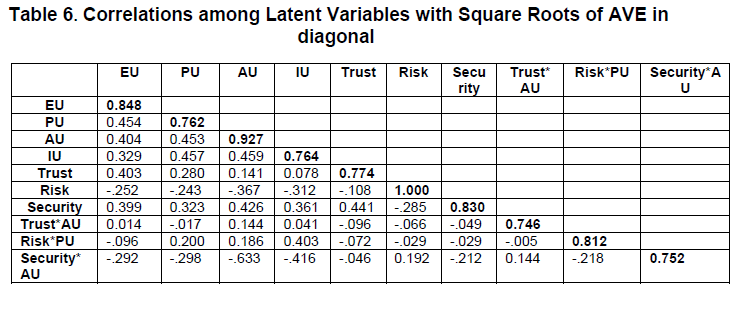 |
| In table 6 we can notice that the variable Risk has a negative relationship with all latent variables, as well as the variable Security with variable Risk and Security*AU with mostly all the other variables. The perception of Risk has a negative impact on all major latent variables. |
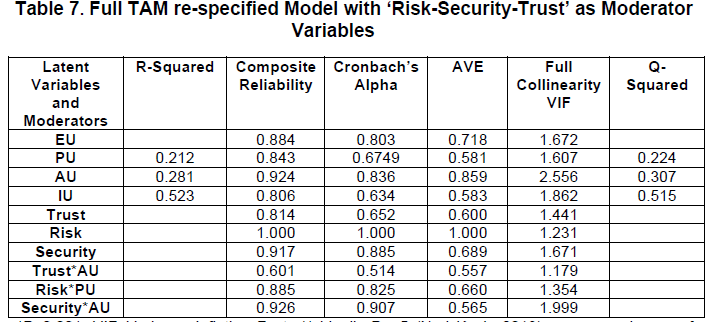 |
| *P<0.001, VIF=Variance Inflation Factor** ideally P<=5 (Ned Kock, 2013) measures degree of multicollinearity among variables. Q-Squared measures predictive validity it is similar to the R2calculated via Blindfolding. |
DISCUSSION |
| In comparison with the base model, the introduction of three moderator variables has substantially changed the value of the original parameters. |
| In summary, with the introduction of these moderating variables, the relation between PU and IU has decreased from 0.33 to 0.25, particularly due to the moderation of Risk a an important customer perception variable. |
| Furthermore, the relation between AU to IU decreased from 0.34 to 0.25, due to the moderation of Security and Trust. However the IU R2 increased from 0.31 to 0.52, suggesting that the moderation variables Security and Trust have a positive impact on customers’ use of internet for bank financial transactions. So, adding these three moderation variables has substantially increased the value of the IU R2. Consequently, this model seems to be appropriate when moderating the relations of latent variables PU to IU and AU to IU. |
| When the global model is re-specified, we can notice that Risk has a major impact on perceptions (PU to IU), along with the major impact of Security and Trust on attitudes and behaviour. Customers will feel the Risk as a difficulty in making financial transactions on the internet, but this is overruled by the Security measures put in place by the financial institution, along with the Trust on the posted system that will increase the confidence of making financial operations. The joint moderation of Risk, Security and Trust has a substantial impact on the variable Intention to Use (IU). |
| These findings may have some interesting managerial implications in order to help customers feel comfortable when using internet to make their financial transactions. In first place, banks or financial institutions need to create and enhance confidence and trust on the internet processes to transfer data, as well as provide an adequate and clear interaction between customers and the institution, privacy and security protection, system reliability and financial quality information (D, J. Kim, D, L, Ferrin, H, Rahav Rao, 2007). |
LIMITATIONS AND CONCLUSION |
| This research has some limitations. The major limitation of the present study is that the sample is based on secondary students which have a bank account and use internet for completing bank operations. These sample profile corresponds to a very specific segment of the population, mostly educated customers that do not necessarily have the same needs than other segments. Thus, the sample characteristics could introduce slight skews (bias) in the results obtained. |
| Secondly, the use of Partial Least Squares optimisation method does not permit to consider these results as a confirmatory solution, but much more as exploratory. The generalisation of results has been made through bootstrapping using the blindfolding method (Ned Kock, 2013). Third, the validation of scales could not be done in the same way as in confirmatory analysis; the validation has been done previously (see Lévy Mangin et al, 2012). |
| Finally, this research provides with some interesting insights to bank managers. Further innovation should be oriented in creating more consumers’ data protection mechanisms in order to develop Trust (in mechanisms and in products) and Security on those mechanisms and in offering secure and adapted financial products that could match or exceed the competitors’ offer. Good communication with users will be very important to lower the intensity of the perceived Risk on financial transactions and on the products’ purchase (Curras Perez, R., Sanchez Garcia, 2012). On line banking should be completed by the development of phone on line financial counselling, in the site or in the internet, with easy access and interaction, very efficient and at the best cost. |
| Following these recommendations would help customers in developing the same confidence and trust when making financial transactions on the internet, than when the same transactions are made at the bank office. |
References |
|
Copyright © 2025 Research and Reviews, All Rights Reserved